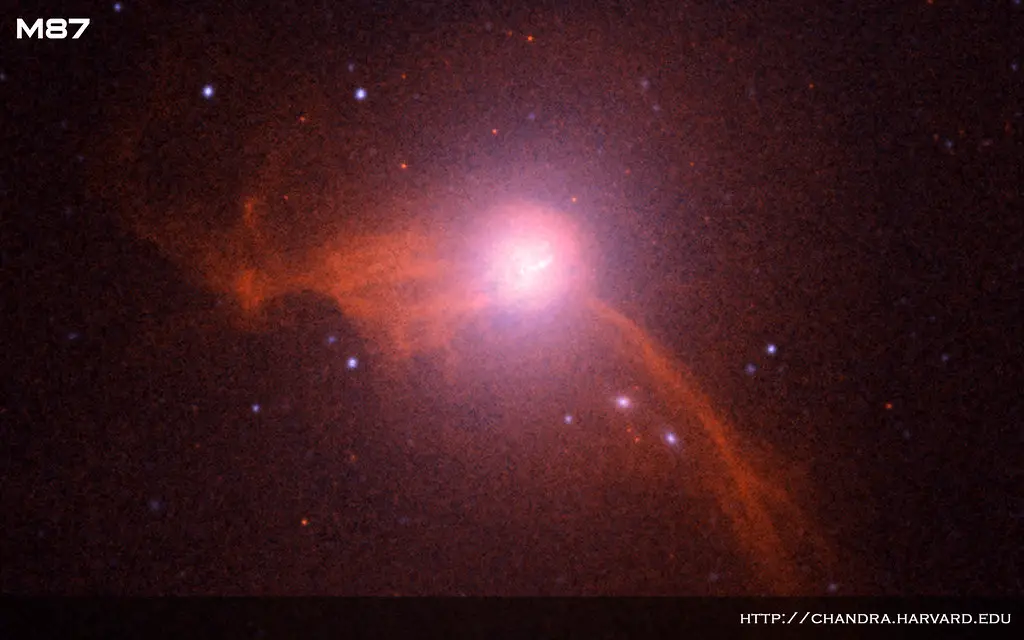The universe is a vast and mesmerizing expanse, full of innumerable galaxies that have caught the attention of both astronomers and stargazers alike. These galaxies can be found across the universe. The M87 galaxy, sometimes referred to as the Messier 87 galaxy, is one example of this type of galaxy that has interested scientists for decades. M87 is a gigantic elliptical galaxy that can be found in the constellation Virgo. Its distance from Earth is roughly 53.5 million light-years, and it is located there. This celestial wonder has never failed to interest the imagination of astronomers, in particular due to the unique features it possesses and the mysterious object that sits at its center.
The enormous size of the M87 galaxy is one of the most distinguishing features of its cosmic neighborhood. It is one of the largest known galaxies in the local universe, with an estimated diameter of roughly 120,000 light-years, making it one of the largest in the cosmos overall. Because it is an elliptical galaxy, which means it does not have the distinctive spiral arms that are seen in galaxies like our own Milky Way, its enormous size can be linked to the fact that it lacks these features. In contrast, M87 has a smooth and extended form, and the stars that orbit the galaxy’s center appear to be doing so in a somewhat haphazard manner.
An unusual phenomena known as a supermassive black hole can be found at the galactic center of the M87 galaxy. The attention of experts all across the world has been drawn to this particular black hole, which possesses a mass that is comparable to billions of suns. The supermassive black hole that is located at the center of the galaxy known as M87 was the subject of the very first direct image of a black hole, which was revealed in 2019 by the Event Horizon Telescope (EHT) project. This image, which showed a brilliant ring encircling a darker region in the center, revealed insights into the nature of these extraterrestrial beings that had never been seen before.
The active accretion of matter by the black hole at the center of M87 results in the formation of an accretion disk surrounding the black hole. When matter falls into a black hole, it unleashes vast quantities of energy in the form of high-energy jets that can travel millions of light-years in any direction. These jets are responsible for the emission of strong radiation at a variety of wavelengths, including as radio waves, X-rays, and gamma rays. The precise mechanisms that develop and maintain these jets are still the subject of ongoing research, but it is believed that they are impacted by the intense gravitational forces and magnetic fields that are located close to the event horizon of the black hole.
M87 has revealed a number of fascinating phenomena, in addition to its enormous black hole, which is rather remarkable. One example of such a phenomenon is the existence of a massive jet that extends outward from the galactic core. This jet has a length of about 5,000 light years and is made up of very energetic particles that are moving at almost the speed of light. The intense gravitational forces created by the black hole are thought by scientists to be the source of the jet. These gravitational forces are responsible for the acceleration and propulsion of the particles in question.
The investigation of galaxy M87 has not only made significant contributions to our knowledge of the characteristics of supermassive black holes, but it has also helped us better comprehend the processes that lead to the formation and development of galaxies. Astronomers have a better knowledge of the process by which galaxies develop over the course of time because to their observations of the movement and dispersion of stars inside M87. In addition to this, the tremendous radiation emitted by the black hole and the jet has had an effect on the interstellar medium that is surrounding it, which has shaped the environment of the galaxy and impacted the birth of new stars.
In addition, M87 has been an essential part of astrophysics research and the testing of fundamental theories of gravity since it was discovered. Numerous studies, all with the goal of improving Einstein’s theory of general relativity, have been conducted on the galaxy’s central black hole. The measurements made by the EHT of the black hole known as M87 were essential in establishing the reality of the event horizon and confirming that Einstein’s theory accurately predicts the extreme gravitational effects.
We should anticipate new insights and discoveries pertaining to the M87 galaxy as a result of the continued development of technology and the enhancement of the capabilities of our telescopes. Ongoing studies are intended to investigate the dynamics of the black hole as well as the ways in which it interacts with the environment around it. In addition, astronomers are excited to examine any possible links that may exist between the supermassive black hole in M87 and the development of galaxies in the immediate area of the black hole itself.
The awe-inspiring characteristics and unfathomable cosmic riddles of the M87 galaxy continue to enthrall both professional astronomers and amateur stargazers. Astronomers have access to a plethora of information thanks to the supermassive black hole’s strong jets and enormous size, which allows them to move closer to understanding the mysteries of the cosmos. The more we learn about galaxy M87, the closer we go to knowing the complex workings of galaxies, black holes, and the fundamental forces that form our universe.
![]()
